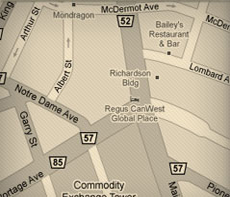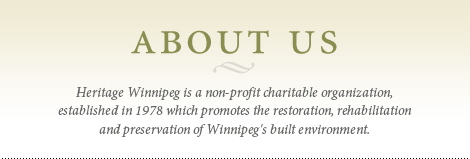Through advocacy we speak on behalf of the preservation of worthwhile buildings threatened by demolition or neglect. Some past efforts include the former Bank of Commerce, Barber House, Kelly House, former Union Tower, and Upper Fort Garry to name a few. This advocacy work continues.
Heritage Winnipeg's Achievements
- Heritage Winnipeg played a very prominent role in the development and adoption of the Province and City's Legislative regulations regarding City of Winnipeg Heritage tax Credit for Heritage Properties.
- Heritage Winnipeg played a valuable role regarding the National Designation of the Exchange District.
- Heritage Winnipeg lobbies governments, i.e., petitions for threatened heritage buildings subject to demolition and also the Sustainable Development Act etc., and many other heritage issues.
How to Become Involved
- Act as a conservation advocate in your neighbourhood, and promoting the cause of heritage conservation through education and other means.
- Write articles on heritage themes and issues for publication in newsletters and other media.
- Students can participate in research in several related fields including urban geography, architecture, city planning, history and economics.
- Work on fundraising programs and/or events.
- Work in the Heritage Winnipeg office.
- Offer time and experience as a Board member or committee member.
May 29, 2018
Carnegie Library: Heritage At Risk
FROM CBC:
Winnipeg's Carnegie Library called one of Canada's most endangered historic sites
City of Winnipeg hasn't decided what to do with former city archives building
A Winnipeg library that is more than a century old and houses the city's archives has been named among the most endangered historic sites in Canada at a time when the future of the building hangs in limbo... read the full story
FROM National Trust for Canada:
Top Ten Endangered List
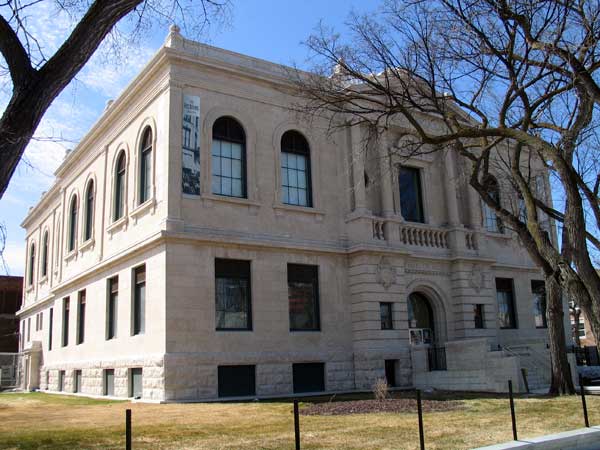
As of May 23, 2018, The National Trust for Canada launched the 2018 Top Ten Endangered List of historic buildings. This year, the former Carnegie Library and City of Winnipeg Archives is on the list. The Carnegie Library, built in 1905 with a $75,000 grant from Andrew Carnegie, was severely damaged by a rainstorm in 2013 while undergoing renovations. Although a designated heritage building, its future is uncertain - express your support for the preservation of this building by emailing us at info@heritagewinnipeg.ca.
Carnegie Library at the National Trust
October 5, 2017
Heritage Winnipeg makes bid to save lavish Oak Room at the St. Regis Hotel: UPDATE
Heritage Winnipeg is proud to have worked with Brock Coutts in successfully preserving the Oak Room from the St. Regis Hotel! The Oak Room will be incorporated into Coutts' purposed whisky distillery, Patent 5, which will be located in the Dominion Express Company Building, a heritage building at 108-112 Alexander Avenue. Heritage Winnipeg is grateful for the corporation of Fortress Real Developments and Edenshaw Developments in the removal of the Oak Room from the St. Regis Hotel.From the CBC: Whisky producer eyes warehouse on the edge of Winnipeg's Exchange District
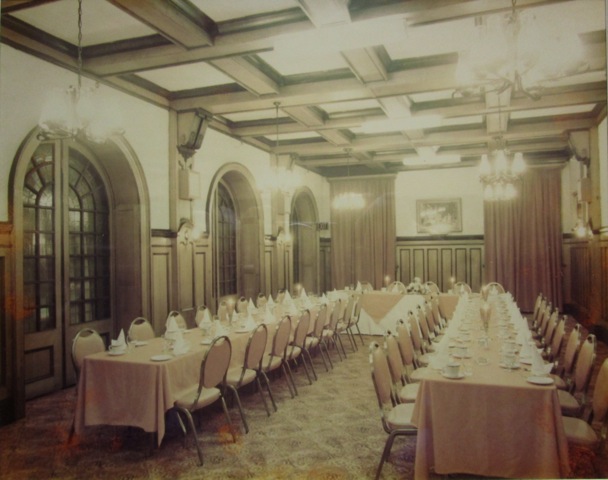
August 3, 2017:
Heritage Winnipeg hopes to preserve the historic Oak Room at the St. Regis Hotel, which is set to be demolished in August.
From the CBC:
Please visit the CBC's website to read the rest the full article.With just weeks before the building is set to be demolished, Heritage Winnipeg is hoping to preserve the grandeur of the St. Regis Hotel's Oak Room.
Just as its name says, the century-old banquet area is extensively panelled in oak, where it has a storied history on the first floor of the old hotel on Smith Street.
Fortress Real Developments plans to build a commercial space and parkade after the demolition of the building begins in August
"What we'd like to see is some help or some support with the city and maybe someone in the private sector to help us dismantle the room, preserve it ... ultimately to be showcased in another heritage building," said Cindy Tugwell, executive director of Heritage Winnipeg
March 21, 2017
Voice Your Support! Federal Incentives for the Rehabilitation of Canada's Historic Places
Update from the National Trust of Canada -
Thanks to your efforts and the letters written by many heritage supporters, MPs voted in the House of Commons today, March 23, 2017 to send Bill C-323 to theStanding Committee on Environment and Sustainable Development – an important step in making tax incentives a reality!
Take a moment to savour this historic milestone in the 40 year campaign to achieve tax incentives for historic places in Canada.
We urge you to thank your MP for voting YES. Find out here how your MP voted.
Where are we in the process?
Second Reading Vote to Send to Committee
Passed, Thursday, March 23
Committee Stage
The Committee has up to 60 sitting days to consider it, make any amendments, and bring it back to Parliament.
Report Stage Reading (Back to House of Commons)
There will be debate (two one-hour sessions) and voting on proposed amendments the following week. The process could take up to 30 days.
Third Reading
More debate (two one-hour sessions) and a vote – if passed, the Bill goes to Senate for debate and passing, Royal Assent, and becomes law.
Considering there are only between 33 and 44 sitting days left in the Parliamentary Calendar before the summer break, we are unsure if how far the Bill will proceed this spring.What’s next? We still have work to do! Your continued support will be needed to ensure that members of the Standing Committee on Environment and Sustainable Development are aware that Canadian communities need the measures proposed in Bill C-323.
Update March 17 – House of Commons to vote on Bill C-323 on Thursday, March 23. Vote will either kill Bill or send it to the Standing Committee on Environment and Sustainable Development for further discussion. It’s not too late to contact your local MP!
Update March 2 – Second hour of House of Commons debate on Heritage Tax Bill C-323 may be set for Thursday, March 9. Vote to kill bill or to send committee – March 22.
Update Feb. 13 – First hour of debate on Heritage Tax Bill C-323 took place in House of Commons
Bill C-323 includes the creation of:
- A 20% tax credit on eligible costs of rehabilitation work done to designated historic places (commercial & owner-occupied residential); and
- An accelerated Capital Cost Allowance (25%/50%/25%) for eligible capitalized costs incurred under the same conditions of the tax credit (commercial only)
These two tax measures would transform the economic fundamentals for renewing historic places. In the process would create more skilled jobs and generate less carbon and new construction.
You’ll find information about Bill C-323 and background materials to help you take action below.
1. Write to your MP, or ask for a meeting, or both! Point to historic places in your riding that need this kind of financial measure – especially those at risk!
Here is a link to find your MP by postal code: https://goo.gl/Yt9R9q
2. Write a letter to the Minister of the Environment, who is responsible for built heritage in Canada. A real letter is much more effective than an e-mail!
The Honourable Catherine McKenna MP
Minister of Environment and Climate Change
200 Sacre-Coeur Boulevard
Gatineau QC K1A 0H3
http://ec.ministre-minister.ec@canada.ca
If you would like to learn more about the proposed measure please do not hesitate to contact us at our Heritage Winnipeg offices:
Office: 204-942-2663
Email: http://info@heritagewinnipeg.com
Full text of Bill C-323:
https://goo.gl/nkQQMy
National Trust for Canada Webpage:
https://goo.gl/nuyX06
October 11, 2016
Save 514 Wellington Crescent!
This historic and stunning home has stood on the corner of Wellington Crescent and Kingsway, adjacent to St. Mary’s Academy since 1909. The home’s official name is the Gordon residence, named for its first owner James T. Gordon, who worked in the meat packing business. It is a beautifully built home, and Winnipeg will likely never see the likes of it again if it is demolished.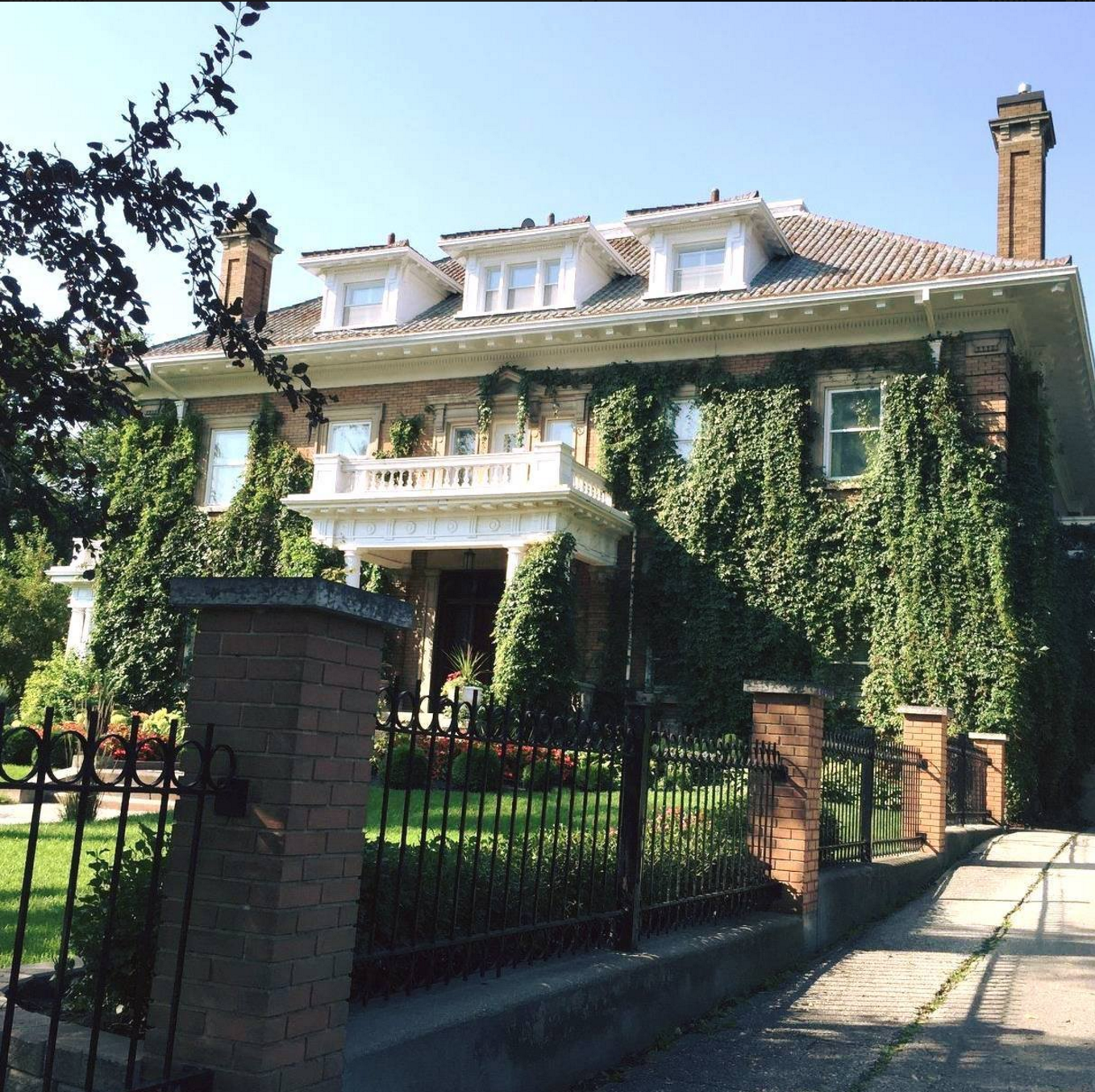
It not only has great architectural value, but a rich social history, with many prominent families calling it home over the years. During the 1920s the Bawlf family, who founded the Grain Exchange owned the home, and the Grain Exchange had a huge impact on the development of Winnipeg as a City. During the 1940s, Victor Sifton, the owner and publisher of the Winnipeg Free Press, lived in this home and until earlier this year, the home was owned by former Senator Douglas Everett who maintained it meticulously. Currently Leader Equity Partners, a Winnipeg development firm, have purchased the 107-year-old, 8,000-square-foot home, and potentially want to demolish it to build a new condo development on the property.
Along with Heritage Winnipeg many people in the heritage community are outraged, and many of the residents of the Crescentwood Association are rallying to help save the home. Visit save514wellington.com for more information, and click here to add your name to the petition to help save this beautiful historic home. Click here to go to blog.
Capitol Theatre Now Being Demolished
The Capitol Theatre has been removed from the city’s historical buildings list and is being demolished.As of Tuesday, February 26th, 2002, demolition crews cracked open the roof of the Capitol theatre, exposing the grand, domed ceiling that once greeted movie-goers in the golden age of cinema. The debris should be removed by March 15th, 2002. (Winnipeg Free Press, February 27th, 2002)
The Capitol Theatre was constructed in 1920 by the prestigious North American theatre architect, Thomas W. Lamb. The theatre was innovative because it distinguished itself by replacing the usual “double cliff hangers” by a single balcony with a gentle slope and moving the visually obstructive balcony columns behind the last row of seats. In its day, the theatre was one of the most lavish and attractive movie palace auditoriums in Winnipeg.
A recent engineering report of the building stated that the interior features a host of problems, including mould and asbestos. A new roof was also desperately needed by the building.
After looking at the Capitol, an interior architectural consulting company found a number of items that are to be salvaged. These include stained glass exits signs, described as “original and hard to come by”, art deco wall sconces from 1929, music stands in the orchestra pit which are believed to be original, and a decorative plaster angel, a signature of the original architect, and two ornamental panels. (Winnipeg Free Press: June 5, 2001)
The Raleigh Apartments - 340 Vaughan Street
The Raleigh Apartments: An Asset to the Community
The Raleigh is part of the historical integrity of our community.
Located in a small "heritage zone", the Raleigh is bordered by the Free Press Building, Isbister School, and the YMCA Building.
The Raleigh promotes neighbourhood safety.
This is an area of limited uses. Most of the local facilities are used only during the day and early night. The Free Press and YMCA buildings, Isbister School, the University of Winnipeg and Portage Place Mall are examples.
The Gordon Downtowner is the only use operational besides the Busses, the Raleigh and the Fred Douglas Place during late hours of the night at Vaughan and Ellice.
The Ellice strip is almost completely devoid of residential buildings facing the street.
However, the pressure of residents at the Raleigh is a deterrent to crime. People are constantly coming, going, listening and watching. They keep their feet, eyes and ears on the street, day and night. Therefore, the street is seldom completely abandoned, and thus does not provide an ideal haven for crime.
The Raleigh is an ideal dwelling for a variety of people.
This building offers space for students who attend the University of Winnipeg (the housing available through the university is quite limited), low income families and those who simply enjoy the heart of Winnipeg.
The Raleigh Apartments are an asset to the downtown area and to the people who live and work there.
Tenants Meeting Minutes
Knox United Church
Tuesday, July 17, 2001
7:00 P.M.
The meeting was held so that the tenants of Raleigh Apartments could voice their concerns over the proposed expansion of the Salvation Army (William and Catherine Booth College).
The process of the Salvation Army College expansion was set in motion without anyone knowing. Is there not an alternative expansion location for the Salvation Army College? Maybe somewhere in the downtown area where there are a lot of vacant buildings? Will the Salvation Army provide alternate housing for the residents of the area? The Raleigh Apartments is a good building that has good suites with good long-term residents. The residents have stated that they will not move out of that building. One resident has lived there for over sixteen years. The University of Winnipeg has selective housing and is only purchasing homes, not large blocks.
There has been a push by the City of Winnipeg to revitalize the downtown area, but that should not mean tearing down the residential apartment blocks. It was agree that the media exposure was very important. Someone asked if the Bay Downtown building was in trouble. More low-income housing is needed in the heart of the City. Councillor Harvey Smith was present, and the tenants wanted to see some action, not just empty promises. A Grade III heritage designation was recommended to Councillor Smith by the tenants for the Raleigh Apartment building. Someone suggested that the Central Park Residents Association collaborate and join the residents of Raleigh Apartments. The building is a healthy building that has had low vacancies, and is truly a jewel.
A hearing was held by the Planning and Property Development Committee of the City of Winnipeg on July 5, 2001. The report on the Raleigh Apartments was sent back for community consultation and will go back again to the Property and Planning Department for recommendations. The committee is also waiting for the recommendation from Centre Venture.
The residents of the Raleigh Apartments are to contact Jim August C.E.O. of Forks North Portage Partnership to present their long-term plan. There is a hypocrisy in motion; the Forks mandate is to have a healthy downtown with residential living- the apartments are an integral part of that area for modest income people. The residents will also try to get a Salvation Army College representative to speak with them at a meeting next week.
We are pleased to report that the sale of the Raleigh Apartments has been stopped. The Salvation Army has decided not to purchase the apartment block for the expansion of their College.
The History Of The Raleigh Apartments
One construction project that did not get cancelled during the depression years is the Raleigh Apartments, a large, 37-suite, three-storey apartment block located in the heart of Winnipeg’s downtown.
This block was designed by architect James W. Hawker, a British-trained architect who came to Winnipeg in the early 1920s. His first job was chief draughtsman for James Chisholm and Son, but his career quickly peaked when he became become President of the Manitoba Association of Architects in 1930. Hawker is credited with the design of many buildings including the Wiltshire Apartments on Spence Street, the John A. Forlong House (295 Dromore Avenue) and a retail block at 377 Portage Avenue.
The Raleigh Apartments are architecturally significant because of the style associated with the building– Art-Deco. The Art-Deco style is distinguishable by its flat, sharp edges and low-relief ornamentation, often with unique motifs: geometrical, naturalistic and man-made.
For the construction of the Raleigh Apartments, Hawker decided to use geometric accents, low-relief ornamentation and a vertical arrangement of the windows.
The Raleigh is one of dozens of modestly adorned, three-storey brick apartment blocks that dot streets from one end of the city to the other. While the red brick colouring of the building adds to its visual impact, the Raleigh is best known for its innovative architectural style.
The 1900 construction of the Raleigh block illustrated why apartment blocks were so popular in Winnipeg, both as an investment and as a place of residence. Even though the economy showed signs of collapse, this well—designed, modestly finished block in a central location attracted both the necessary capital for its construction and the necessary tenants to make it viable. - Historical Buildings Committee
Upper Fort Garry Project Update
The "Friends of Upper Fort Garry" recognize the immense importance of this historic site (lands at 100 Main Street), which are now currently surplused and for sale by the City of Winnipeg. This site is the birthplace of Winnipeg and Manitoba and recognized as such in the EOI submission. We will continue to update this site as this project progresses. Further information is available through the office at Heritage Winnipeg or Friends of Upper Fort Garry at 204-947-5073 and www.upperfortgarry.com.
Reports for Download:
Heritage Buildings At Risk Update:
The Ryan Building - 104 King Street -
Following a fire in 1991, the boarded-up King building has been left to the elements—a classic case of demolition by neglect.
Located smack in the middle of Winnipeg's stunning Exchange District—an area declared a National Historic Site in 1997 and a location for films like the Oscar-winning “Capote”—is the four-storey 19th-century warehouse. Vacant for the past 15 years, it sits at a prominent intersection, kitty-corner to Old Market Square in the heart of the Exchange where summer festivals are held. The city of Winnipeg designated the King Building as a Grade 2 heritage structure in 1988. Its owner, Bedford Investments, appears determined to raze it for a parking lot.
Its resilience is a testament to its robust construction. Built in 1895 of brick, large timber beams, and Tyndall stone, the King Building was one of the first Winnipeg warehouses built in the Richardsonian Romanesque style, a Chicago-derived style that reflected Winnipeg's desire to become the “Chicago of the North.”
The warehouse is being watched by Heritage Winnipeg, and the city enforces some basic protection using the “Vacant and Derelict Buildings Bylaw.” A 2005 city report found the roof leaking, floors and ceilings collapsing, the fire alarm inoperable, and bricks loose on its exterior. Bedford Investments claims redevelopment of the property is not economically viable, but refuses to sell it. The owner would like to combine the King Building site with the surface parking lot it owns next door, possibly to erect a parkade.
(Information Courtesy of)
Heritage Canada website at www.heritagecanada.org - Top Ten list of endangered places in Canada
Currently CentreVenture Development Corporation is working with the City of Winnipeg to stabilize the building and the cost will be put on the owner's (Bedord Investments) tax bill.



